Forum Discussion
professor95
Apr 27, 2011Explorer
Just sharing.....
I have an electric start Champion 40008 skinned out and converted to propane in the front compartment of my fifth wheel. For anyone that wasn't around when I did the initial write-up, cooling is accomplished by a down draft fan that is in a box under the generator. A second fan is attached to the end of the alternator to assure cool air flow across the AVR and insides of the alternator.
The muffler was removed and mounted under the trailer.
Well, after three seasons of use, the original exhaust system pretty much fell apart and needed to be redesigned/replaced.
This post is about how the exhaust was redone. Again, just sharing how it was accomplished for anyone thinking about a similar exhaust system.
A critical component in an exhaust system for an internally mounted generator is a flexible union that will allow movement of the generator but keep the exhaust rigid.
This time I purchased a flexible section at Advance Auto. It was a small unit about 9" long with 1-1/2" inlet & outlet. I think the cost was something like $30.
I cut the inlet/outlet pipes off and welded in two black iron adapters that had an OD of 1-1/2" and a threaded center for 3/4" rigid pipe.
The finished flex section is shown below.
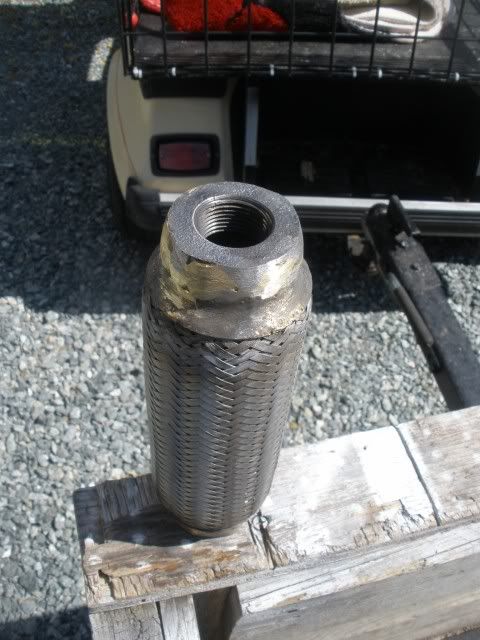
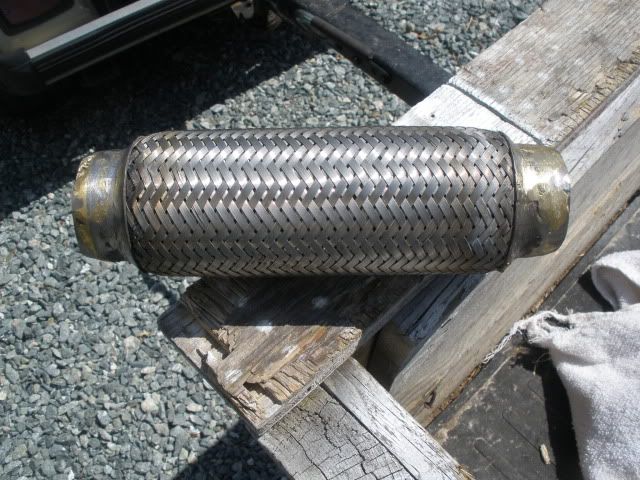
BELOW: The exhaust manifold was constructed from 3/4" black iron pipe welded to a flange that bolted to the engine. To make the first 90 degree turn to the flex section two 45 degree sections were used back to back to make a smoother 90 degree turn. This same method was used for the second 90 degree turn after the flex section.
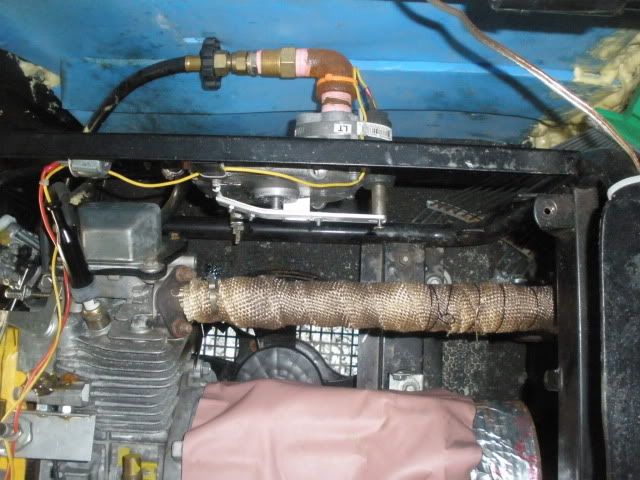
The above shot shows the straight section from the engine. It is wrapped with three layers of 2" header wrap as insulation. The pink stuff is a high temperature insulating material to help keep the alternator cooler. Since the engine is fueled with propane, there is no gas tank. You can see the LPG low pressure regulator at the top of the photo. You can also see the center (motor) and part of the blades on the down-draft fan in the box under the generator and daylight from the driveway through the exhaust grill.
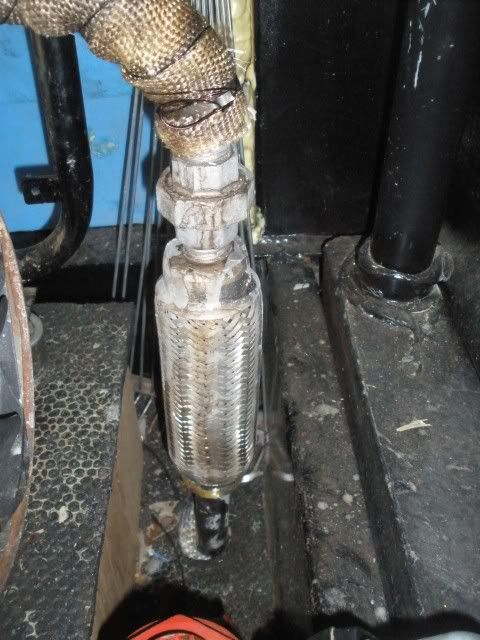
Above is the flex section just before it connects to another 3/4" pipe that exits through the steel floor of the front compartment. Note the common pipe union on top so the exhaust can be disconnected if I need to remove the engine or entire generator.
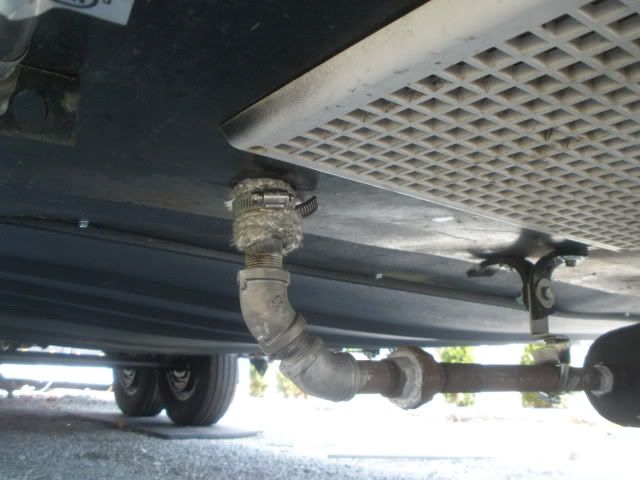
Above: Once the exhaust comes through the floor to the outside it makes a turn. Note the two 45 degree pieces used with a close nipple rather than a sharp 90 degree turn. A second pipe union is before the muffler so that part can be removed for service/repair if needed. Where the pipe goes through the floor is a wrap of fiberglass rope used for a gasket on furnaces and wood stoves. It is held in place with common hose clamps - one inside, the other outside as shown. This eliminates any vibration noise from the metal pipe to the compartment steel floor. It also keeps critters out. The white grill is over the cooling exhaust fan.
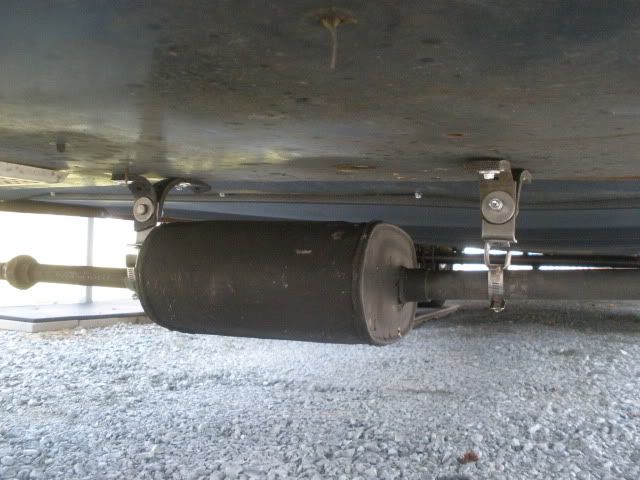
Above: The stock muffler has been modified by welding on 3/4" threaded pipe nipples. The muffler and pipe are supported by standard tail pipe hangers with the rubber hanger part cut so that they butterfly. Having the butterfly shape allows two bolts to support the hanger and keeps it from "swinging" from side to side. Stainless hose clamps hold the hanger to the pipe. The final tail pipe is a piece of 3/4" EMT that exits on the left side of the camper. The exhaust exit is NOT near any open windows or vents.
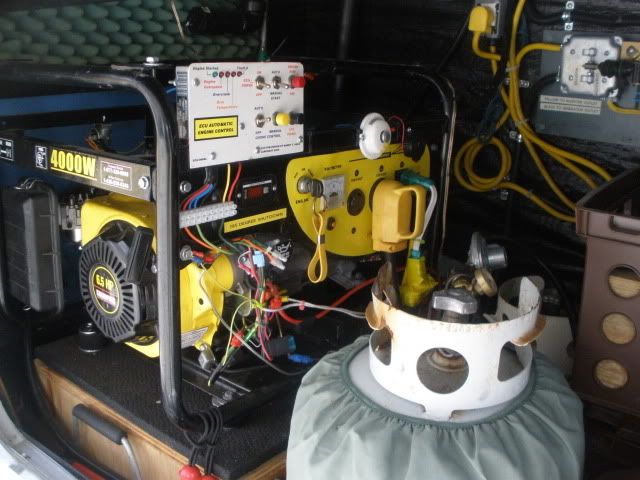
This is the view from the top front. The 20# propane tank is set outside when the generator is used. The hose goes through a cord hatch door and the front cave door is closed.
Measured MAXIMUM exterior sound levels of the unit with the A/C running at the loudest point are 61 dba.
I am really hoping this exhaust system holds up longer than the old one. With the flex section I anticipate it will be there for a long time.
BTW - I have NOT noticed any reduction in power from the generator due to what I am sure is an increase in exhaust back pressure. All of the 3/4" black iron pipe came from Lowe's.
I have an electric start Champion 40008 skinned out and converted to propane in the front compartment of my fifth wheel. For anyone that wasn't around when I did the initial write-up, cooling is accomplished by a down draft fan that is in a box under the generator. A second fan is attached to the end of the alternator to assure cool air flow across the AVR and insides of the alternator.
The muffler was removed and mounted under the trailer.
Well, after three seasons of use, the original exhaust system pretty much fell apart and needed to be redesigned/replaced.
This post is about how the exhaust was redone. Again, just sharing how it was accomplished for anyone thinking about a similar exhaust system.
A critical component in an exhaust system for an internally mounted generator is a flexible union that will allow movement of the generator but keep the exhaust rigid.
This time I purchased a flexible section at Advance Auto. It was a small unit about 9" long with 1-1/2" inlet & outlet. I think the cost was something like $30.
I cut the inlet/outlet pipes off and welded in two black iron adapters that had an OD of 1-1/2" and a threaded center for 3/4" rigid pipe.
The finished flex section is shown below.


BELOW: The exhaust manifold was constructed from 3/4" black iron pipe welded to a flange that bolted to the engine. To make the first 90 degree turn to the flex section two 45 degree sections were used back to back to make a smoother 90 degree turn. This same method was used for the second 90 degree turn after the flex section.

The above shot shows the straight section from the engine. It is wrapped with three layers of 2" header wrap as insulation. The pink stuff is a high temperature insulating material to help keep the alternator cooler. Since the engine is fueled with propane, there is no gas tank. You can see the LPG low pressure regulator at the top of the photo. You can also see the center (motor) and part of the blades on the down-draft fan in the box under the generator and daylight from the driveway through the exhaust grill.

Above is the flex section just before it connects to another 3/4" pipe that exits through the steel floor of the front compartment. Note the common pipe union on top so the exhaust can be disconnected if I need to remove the engine or entire generator.

Above: Once the exhaust comes through the floor to the outside it makes a turn. Note the two 45 degree pieces used with a close nipple rather than a sharp 90 degree turn. A second pipe union is before the muffler so that part can be removed for service/repair if needed. Where the pipe goes through the floor is a wrap of fiberglass rope used for a gasket on furnaces and wood stoves. It is held in place with common hose clamps - one inside, the other outside as shown. This eliminates any vibration noise from the metal pipe to the compartment steel floor. It also keeps critters out. The white grill is over the cooling exhaust fan.

Above: The stock muffler has been modified by welding on 3/4" threaded pipe nipples. The muffler and pipe are supported by standard tail pipe hangers with the rubber hanger part cut so that they butterfly. Having the butterfly shape allows two bolts to support the hanger and keeps it from "swinging" from side to side. Stainless hose clamps hold the hanger to the pipe. The final tail pipe is a piece of 3/4" EMT that exits on the left side of the camper. The exhaust exit is NOT near any open windows or vents.

This is the view from the top front. The 20# propane tank is set outside when the generator is used. The hose goes through a cord hatch door and the front cave door is closed.
Measured MAXIMUM exterior sound levels of the unit with the A/C running at the loudest point are 61 dba.
I am really hoping this exhaust system holds up longer than the old one. With the flex section I anticipate it will be there for a long time.
BTW - I have NOT noticed any reduction in power from the generator due to what I am sure is an increase in exhaust back pressure. All of the 3/4" black iron pipe came from Lowe's.
About Technical Issues
Having RV issues? Connect with others who have been in your shoes.24,337 PostsLatest Activity: Nov 21, 2025